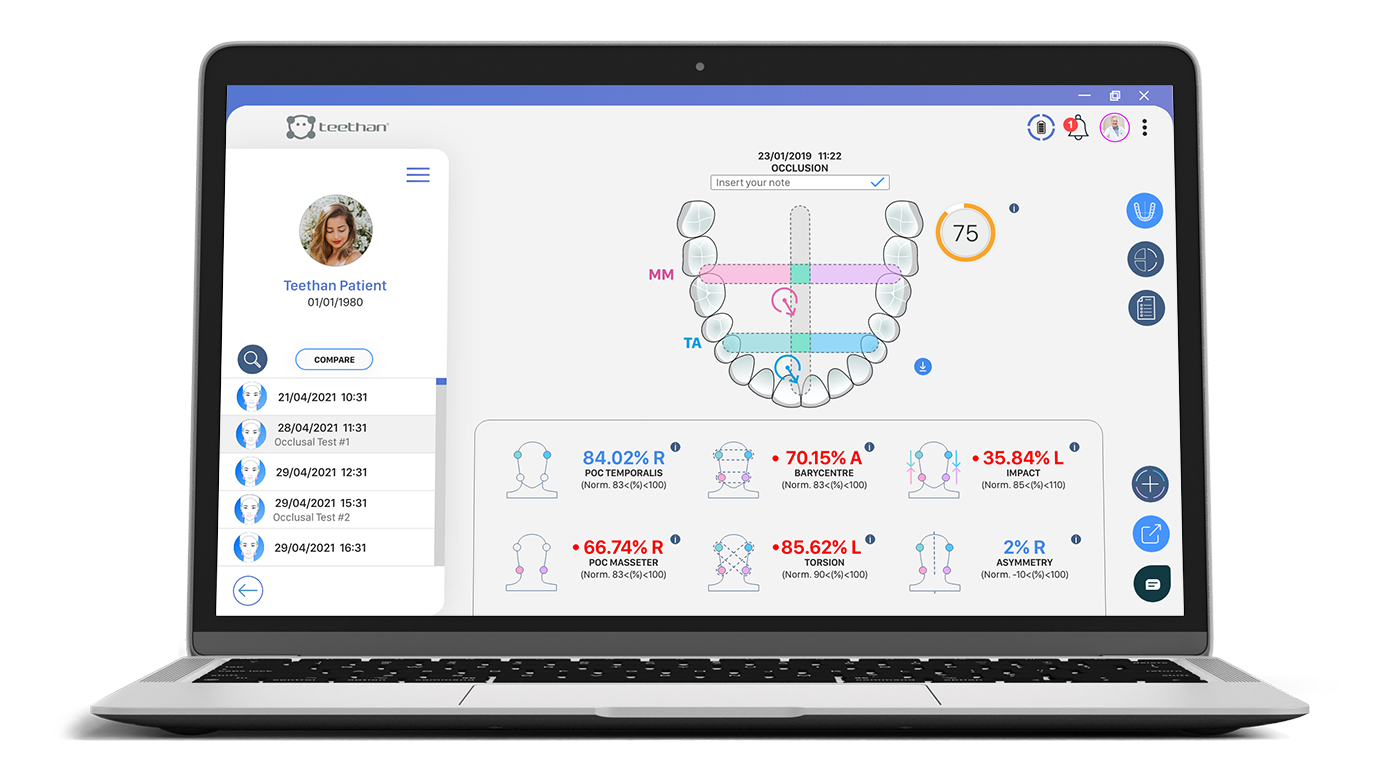TEETHAN IS AN INNOVATIVE TOOL FOR THE FUNCTIONAL ANALYSIS OF DENTAL OCCLUSION. IT ALLOWS TO EVALUATE THE ACTIVITY OF THE MAIN MASTICATORY MUSCLES, ANTERIOR TEMPORALIS AND MASSETERS.
Three simple reasons
Digital Analysis
The exam consists of two tests to measure muscle activity in maximum intercuspidation: the first one is carried out by interposing two salivary cotton rolls between the upper and lower arch; the second one, carried out in natural intercuspidation, allows to detect the parameters of the occlusal plate. Each test lasts 5 seconds, at the end of which Teethan processes the values of the muscular activity recorded.
Report
At the end of the examination, the report generated by Teethan is extremely clear and of immediate interpretation. The graphic synthesis of the collected data allows the patient to understand, in a visual way, his occlusal condition and the necessary interventions to improve it.
Scientific Validity
Teethan's functions are based on 20-years-worth of scientific evidence and research: results have demonstrated the repeatability and reliability of the method and the scientific value of the indices obtained.
OCCLUSAL TEST
STATIC
In order to measure dental occlusion's balance, the patient has to perform two 5-seconds-long clenching tests. The first is performed using cotton rolls, the second without. Test is completed after the two clenches. Then, an easy-to-interpret report is generated. The test can be easily repeated as it takes just few minutes each time. From the examination we obtain 5 main indices useful for the analysis of the occlusal state. For each index, the relative normality band is available:

Percent overlapping coefficient - POC
Given for each muscle pair, it identifies the overall activity of the temporalis and masseters specifying the side of the muscle that prevails within the pair. It allows to evaluate the overall activity of the muscles as well as to understand the muscle that works more within the pair.

Barycentre - BAR
It compares temporalis activity with masseters activity revealing which, among the two, prevails. Physiologically, a posterior center of gravity is preferred, i.e., where masseters predominate over temporalis.

Torsion - TORS
It assesses the cross activity of the pairs of muscles, revealing the torsional attitude of the mandible in the horizontal plane.

Muscular work - IMPACT
It evaluates the intensity of muscle work of analyzed muscles, returning a parameter closely related to the strength of the bite. A very high work is an indication of a clenching patient, a very low one reveals the presence of nociceptive pain. Knowing the extent of muscle work is also particularly interesting for the research of the correct vertical dimension of the patient.

Asymmetry - ASIM
It compares the activity of right-sided muscles with left-sided muscles indicating any symmetry and allows identification of the dominant side on the patient's occlusal plane.

CHEWING TEST
DYNAMIC
It allows to evaluate the neuromuscular coordination in dynamic condition, that is during the chewing act. The test involves two trials of 15 seconds each, performed by a chewing gum, involving first the right side and then the left side of the mouth. From the analysis of the tests, the following indices are considered:

Symmetrical Mastication Index - SMI
It compares the neuromuscular coordination in the two tests. The optimal value is 100%, the further we deviate from it, the greater the masticatory uncoordination.

Chewing frequency
It evaluates the number of chewing acts per second.

Impact
It evaluates work produced by temporalis and masseters during chewing cycles performed on the right side first, and then on the left side. Not normalized impact of the working side is also reported.


